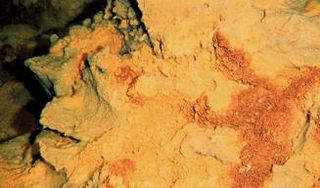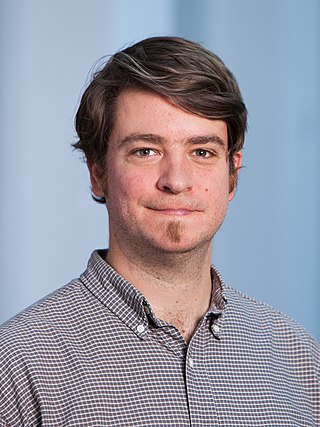
Geomicrobiology is the scientific field at the intersection of geology and microbiology and is a major subfield of geobiology. It concerns the role of microbes on geological and geochemical processes and effects of minerals and metals to microbial growth, activity and survival. Such interactions occur in the geosphere, the atmosphere and the hydrosphere. Geomicrobiology studies microorganisms that are driving the Earth's biogeochemical cycles, mediating mineral precipitation and dissolution, and sorbing and concentrating metals. The applications include for example bioremediation, mining, climate change mitigation and public drinking water supplies.

The Lost City Hydrothermal Field, often referred to simply as Lost City, is an area of marine alkaline hydrothermal vents located on the Atlantis Massif at the intersection between the Mid-Atlantic Ridge and the Atlantis Transform Fault, in the Atlantic Ocean. It is a long-lived site of active and inactive ultramafic-hosted serpentinization, abiotically producing many simple molecules such as methane and hydrogen which are fundamental to microbial life. As such it has generated scientific interest as a prime location for investigating the origin of life on Earth and other planets similar to it.

Gammaproteobacteria is a class of bacteria in the phylum Pseudomonadota. It contains about 250 genera, which makes it the most genus-rich taxon of the Prokaryotes. Several medically, ecologically, and scientifically important groups of bacteria belong to this class. It is composed by all Gram-negative microbes and is the most phylogenetically and physiologically diverse class of Proteobacteria.

The class Zetaproteobacteria is the sixth and most recently described class of the Pseudomonadota. Zetaproteobacteria can also refer to the group of organisms assigned to this class. The Zetaproteobacteria were originally represented by a single described species, Mariprofundus ferrooxydans, which is an iron-oxidizing neutrophilic chemolithoautotroph originally isolated from Kamaʻehuakanaloa Seamount in 1996 (post-eruption). Molecular cloning techniques focusing on the small subunit ribosomal RNA gene have also been used to identify a more diverse majority of the Zetaproteobacteria that have as yet been unculturable.
The Deep Carbon Observatory (DCO) is a global research program designed to transform understanding of carbon's role in Earth. DCO is a community of scientists, including biologists, physicists, geoscientists and chemists, whose work crosses several traditional disciplinary lines to develop the new, integrative field of deep carbon science. To complement this research, the DCO's infrastructure includes public engagement and education, online and offline community support, innovative data management, and novel instrumentation development.
Katrina Jane Edwards was a pioneering geomicrobiologist known for her studies of organisms living below the ocean floor, specifically exploring the interactions between the microbes and their geological surroundings, and how global processes were influenced by these interactions. She spearheaded the Center for Dark Energy Biosphere Investigation (C-DEBI) project at the University of Southern California, which is ongoing. Edwards also helped organize the deep biosphere research community by heading the Fe-Oxidizing Microbial Observatory Project on Loihi Seamount, and serving on several program steering committees involving ocean drilling. Edwards taught at the Woods Hole Oceanographic Institution (WHOI) and later became a professor at the University of Southern California.[1][2]
Victoria J. Orphan is a geobiologist at the California Institute of Technology who studies the interactions between marine microorganisms and their environment. As of 2020, she is the Chair for the Center of Environmental Microbial Interactions.
Marie Edmonds is a professor of volcanology and geology in the Department of Earth Sciences at the University of Cambridge whose research focuses on the physics and chemistry of volcanic eruptions and magmatism and understanding volatile cycling in the solid Earth as mediated by plate tectonics. She is interested in the social and economic impacts of natural hazards; and the sustainable use of Earth's mineral and energy resources. Professor Edmonds is the Vice President and Ron Oxburgh Fellow in Earth Sciences at Queens' College, Cambridge; and the Deputy Head of Department and Director of Research at the Earth Sciences Department, University of Cambridge.

Dimitri Alexander Sverjensky is a professor in Earth and Planetary Sciences at Johns Hopkins University where his research is focused on geochemistry.
Mitchell Sogin is an American microbiologist. He is a distinguished senior scientist at the Marine Biological Laboratory in Woods Hole, Massachusetts. His research investigates the evolution and diversity of single-celled organisms.
Fumio Inagaki is a geomicrobiologist whose research focuses on the deep subseafloor biosphere. He is the deputy director of the Research and Development Center for Ocean Drilling Science and the Kochi Institute for Core Sample Research, both at the Japan Agency for Marine-Earth Science and Technology (JAMSTEC).
Wang Fengping is a Chinese marine microbiologist who studies microbes that live in deep sea and subsurface environments, with a special focus on the physiology and geochemical roles of organisms that cannot yet be cultivated in the lab. She is a professor at Shanghai Jiao Tong University.
Dr. Thomas L. Kieft is an environmental microbiologist who investigates the ecology and biogeochemistry of microbes in extreme environments. He is a professor of Biology at New Mexico Institute of Mining and Technology.

Mark Alexander Lever is a microbial ecologist and biogeochemist who studies the role of microorganisms in the global carbon cycle. He is a professor of biogeochemistry and geobiology at the Marine Science Institute of the University of Texas at Austin.

Frederick (Rick) Colwell is a microbial ecologist specializing in subsurface microbiology and geomicrobiology. He is a professor of ocean ecology and biogeochemistry at Oregon State University, and an adjunct and affiliate faculty member at Idaho State University.
Erik Harold Hauri was an American geochemist at the Carnegie Institution for Science. He researched the movement of matter inside planets and how volatile compounds such as water originated on Earth and other planetary bodies, and their effects on volcanic systems.
Isabelle Daniel is a mineralogist at the Claude Bernard University Lyon 1 in Lyon, France. She studies minerals under extreme conditions, such as those that exist in Earth's mantle, as well as biosignatures of early life.
The deep biosphere is the part of the biosphere that resides below the first few meters of the surface. It extends down at least 5 kilometers below the continental surface and 10.5 kilometers below the sea surface, at temperatures that may reach beyond 120 °C (248 °F) which is comparable to the maximum temperature where a metabolically active organism has been found. It includes all three domains of life and the genetic diversity rivals that on the surface.

The Von Damm Hydrothermal Field is a field of hydrothermal vents located just south of Grand Cayman in the Caribbean, on the Mid-Cayman Rise in the Cayman Trough. It is approximately 24 kilometres (15 mi) south of the Beebe Vent Field. The vent field is named in commemoration of geochemical oceanographer Karen Von Damm, who died in 2008.

Peter H. Barry is an American geochemist who is an associate scientist in the marine chemistry and geochemistry department at the Woods Hole Oceanographic Institution. He uses noble gases and stable isotopes to understand the volatile history and chemical evolution of Earth, including the dynamic processes of subduction, mantle convection and surface volcanism, which control the redistribution of chemical constituents between the crust and mantle reservoirs. Barry’s main research focus has been on high-temperature geochemistry, crust-mantle interactions and the behavior of volatile fluids in the lithosphere. He also studies crustal systems, the origin of high helium deposits, including hydrocarbon formation and transport mechanisms.








